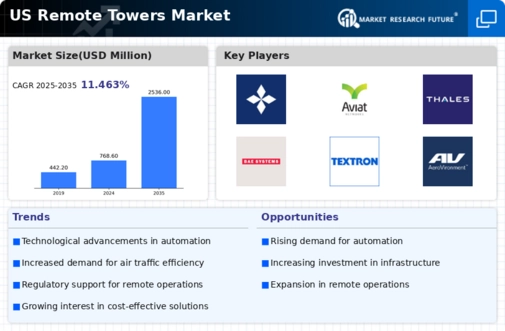The US Remote Towers Market is characterized by rapid technological advancements and an increasing focus on improving air traffic control efficiency and safety. With the proliferation of unmanned aerial vehicles and the growing complexity of airspace management, the demand for remote tower services is on the rise. Companies in this sector are engaged in developing innovative solutions that enable air traffic control from remote locations, providing critical support for airports, especially those with lower traffic volumes or in unserved regions.
The competitive landscape is shaped by a mix of established aerospace giants and emerging technology companies committed to transforming the way air traffic is managed in the United States. This evolving market is expected to witness significant investments and collaborations to enhance operational capabilities and ensure compliance with regulatory requirements while addressing the needs of modern aviation.In the US Remote Towers Market, Bell Helicopter has established a notable presence, leveraging its extensive experience in aviation and commitment to operational excellence.
The company is recognized for its innovative approach to incorporating advanced technologies into their services, which has successfully positioned it within this market. Bell Helicopter's strengths lie in its robust research and development capabilities, enabling the creation of solutions that enhance remote tower functionalities. This includes integration with existing systems and providing scalable solutions tailored to various customer needs.
Furthermore, Bell Helicopter’s reputation for reliability and performance in the aerospace sector serves as a strong competitive advantage, allowing it to forge strategic partnerships and collaborations that expand its market reach while adhering to the evolving regulatory landscape in the United States.Raytheon Technologies plays a vital role in the US Remote Towers Market, known for its comprehensive range of aerospace products and services that include advanced air traffic management systems. The company has developed solutions that optimize situational awareness and enhance the safety and efficiency of air traffic control operations.
Raytheon Technologies' strengths lie in its technological expertise and innovation, which drive its market presence within the remote tower segment. The company actively engages in mergers and acquisitions to expand its capabilities and enhance service offerings, allowing it to remain competitive in a rapidly changing environment. Key products in its portfolio enhance remote tower operations and are instrumental in streamlining communication between ground and airborne traffic. Additionally, Raytheon Technologies invests in cutting-edge research, ensuring that its solutions are at the forefront of industry standards and requirements, thereby reinforcing its stronghold in the US remote towers market.




















Leave a Comment